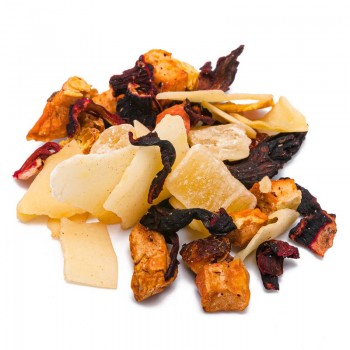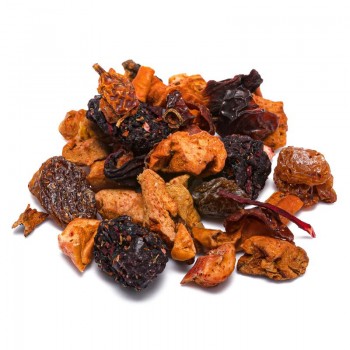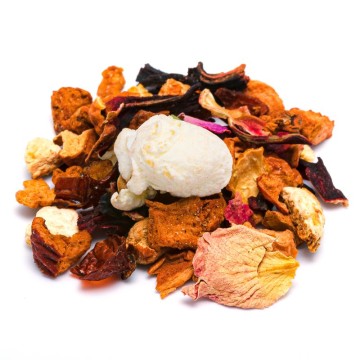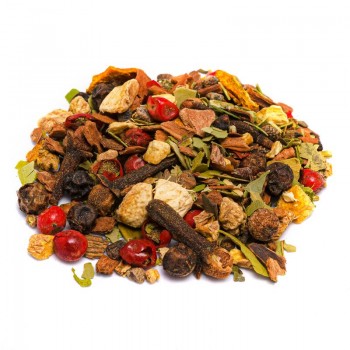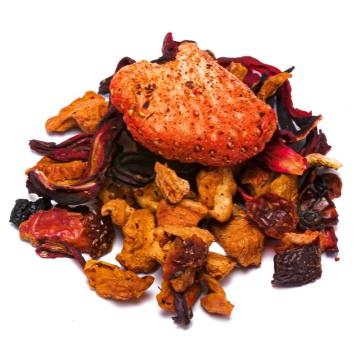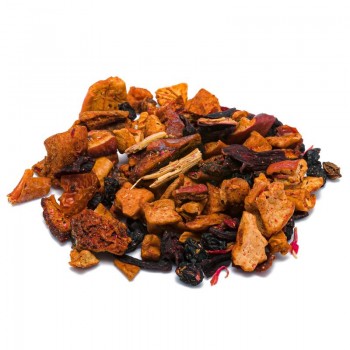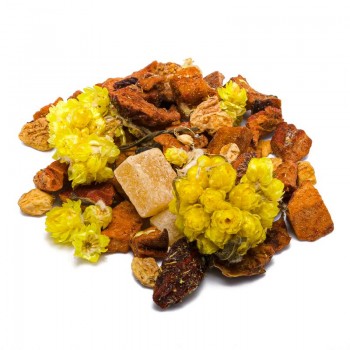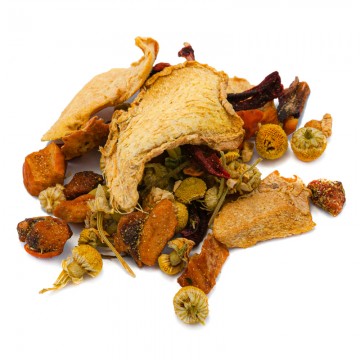Fruit and yerba mate come together for an energizing and pleasant tasting action. The pomegranate, with its sweetness, mixes with mate and other fruits (apple and lemon) for a lively and fresh flavour. Pomegranate flowers and seeds create aromas with fruity nuances based on mate, enhanced by the citrus notes of lemon. An amazing, high-quality and original flavor is born. The flavored mate refreshes with these exceptional notes, mixing the earthy flavor of the herb, with the fruity and sweet pomegranate, devoid of acidity, offset by the provocative tartness of the lemon. Perfect as a fresh and energetic drink on a hot summer day, this infusion can also be taken hot to give more strength to the body and warm it up.
Mate and pomegranate infusion: properties and benefits
The infusion based on yerba mate and pomegranate reserves several healthy virtues. Mate releases its stimulating and energetic components, which make it a delicious substitute for coffee. It provides the infusion with caffeine and theobromine, active ingredients that act as a tonic in counteracting tiredness, fatigue and physical stress. The South American mate allows you to improve physical performance and concentration-attention, reinvigorating your day.
Its refreshing taste and the natural boost of caffeine make this infusion rich in energizing nutritional properties, increased by the presence of pomegranate. Its precious virtues involve the central nervous system and the body's energy levels, benefiting those who practice sports or study. Unlike coffee, it gently stimulates the body without causing agitation or headaches - except in high doses. Furthermore, the infusion can help those who want to calm the feeling of hunger during slimming diets. The mixture with maté, pomegranate is enriched with apple and lemon, proving excellent for promoting digestion and diuresis.
Both mate and apple facilitate intestinal transit, with an effect on the digestive system enhanced by the active ingredients of lemon: it transforms into an alkaline substance that facilitates the absorption of food and reduces toxins accumulated in the digestive tract. Pomegranate also strengthens the intestines and stomach, reducing the inflammation process during digestion. Limonene and other antioxidants in this combination are also useful for stimulating blood and lymphatic microcirculation, with diuretic effects against water retention. The flavonoid antioxidants contained in the infusion help counteract cellular aging and strengthen natural immune defenses. The combination of pomegranate and lemon, especially thanks to the vitamin C content, helps the immune system work. The fruits present in this delicious composition soften the bitter side of mate, creating an aromatic and energizing infusion. It represents a regenerating resource, traditionally prepared cold because it is particularly invigorating.
Origins and history of cultivation
Mate is a drink similar to tea and widespread in many South American countries, where it is called mate, yerba mate, Paraguay tea or Brazilian tea. It comes from the dried leaves (yerba) of the evergreen shrub Ilex paraguariensis, and gives a greenish-coloured infusion, containing caffeine and tannin, less astringent than tea.
It is an ancient Guarani drink, although the plant was first cultivated by Jesuit missionaries in South America (cultivation improved the quality of the infusion). Given its South American origin, mate is particularly widespread in countries such as Argentina, Brazil, Paraguay, Uruguay. Over time it was also used in Syria and in some areas of Lebanon, introduced by Argentine customs. For the traditional preparation of the drink, drying methods vary depending on the country. In Brazil, a fire is lit around the area of beaten earth (tatacua) where the branches are located, for an initial toasting.
We proceed with heating over a fire, and then grind the dried leaves in pits dug in the ground. The leaves are ground into a coarse powder, producing a mate called yerva do polos. In Paraguay and Argentina the leaves are stripped of the veins before roasting, transformed into a mate called caaminí. Recently, a method similar to Chinese tea processing has been adopted, heating the leaves in large cast iron pots.
According to tradition, the mate is placed inside a dried pumpkin or other container, covered with hot water and left to infuse for a short time. They will be sucked from the pumpkin with a metal straw called bombilla, equipped with a strainer to prevent the leaves from ending up in the mouth. Mate is often shared communally, and sometimes flavored with milk, sugar, coffee grounds or lemon juice. The pomegranate is an original shrubinary of the territory between Persia, Iran and the Himalayas in northern India. It has been cultivated in these regions since ancient times and then spread to Armenia and throughout the Mediterranean region. Over the centuries it has become a fruit appreciated in cooking or as a drink (in the Middle East), and pomegranate seeds are still used today as a spice in Indian and Pakistani cuisine. In Turkey it is used to obtain a high quality wine, while in Greece it is used as a condiment or source of a very popular liqueur. It is also famous for its symbolism, because under the hard rind it reveals many small red berries surrounded by pulp, which evoke abundance, fertility and luck. In Christianity it symbolizes the passion of Christ, while for Jews it is the favorite fruit on the Rosh Hashanah holiday. In Greek and Roman mythology it was famous, appearing in wedding and funeral rites. In Greek culture it continues to play a symbolic function, appearing in weddings, funerals and New Year's celebrations. The term pomegranate is also used to indicate the fruit of this tree.
Fruits and flowers
The yerba mate plant is Ilex paraguariensis, which belongs to the holly family, the Aquifoliaceae. The tree is native to subtropical South America, and is known as Mate or Matè. It requires specific pedo-climatic conditions, which is why it is best cultivated only in some small regions of Argentina, Paraguay and Brazil. Furthermore, it requires at least two years between harvests to regrow. It grows up to 8 meters and gives its thick, dark leaves, which are dried to obtain the so-called yerba mate or chimarrão, the famous traditional South American infusions.
The small white flowers bloom in late autumn. In late spring, small red berries appear. The pomegranate fruit comes from the Punica granatum plant, belonging to the Lythraceae family. The plant is native to the territory between Iran and the Himalayan chain, and today grows in many regions of the world, between 5 and 10 m in height. In most cases the pomegranate is a deciduous plant, but in warmer climates it can become evergreen.
It shows shiny leaves and scarlet red flowers, from which the famous fruits derive. The lemon fruit comes from the Citrus limon plant, part of the Rutaceae botanical family. Native to Asia, lemon is cultivated throughout the world for its beneficial fruits and fragrant flowers. It gives different types of fruit, from light yellow to warm yellow. The plant prefers tropical and subtropical climates. The apple comes from the Malus domestica plant, the most widespread species of the Malus genus, belonging to the Rosaceae family. There are thousands of varieties of apple trees grown around the world, available in different sizes, including dwarf ones that grow up to 3 meters tall. Each variety leads to different fruits in color, size, pulp consistency, etc.
Nutritional values of the mate and pomegranate infusion
The infusion contains many nutrients, due to the variety of ingredients. There are certainly many antioxidants and vitamins A, B, C. It makes available various flavonoids, coumarins, phenolic acids, tannins, limonene, theobromine, and energizing substances such as caffeine and theine, and theanine. The minerals in the ingredients include potassium, iron, magnesium, manganese, zinc, copper and phosphorus.
How to use the ingredients in the infusion
The infusion is obtained by placing approximately 3-5 grams of the pomegranate and maté mixture in a cup (250 ml), with water at 100 °C. Leave to infuse for 10 to 12 minutes before drinking. Add honey or sugar, if desired.
Mate and pomegranate infusion: side effects and contraindications The mate and pomegranate infusion brings beneficial effects to the body but with some contraindications. It is necessary to respect the recommended doses and not exceed the consumption of the infusion for too long periods. Excessive intake may cause agitation, diarrhea, headache and nausea. It is recommended to take the infusion with caution to those suffering from cardiovascular and nervous system diseases, due to its caffeine and theobromine content. It is best to avoid consuming it in the evening, because caffeine and theobromine do not promote sleep. It is not recommended for pregnant or breastfeeding women.





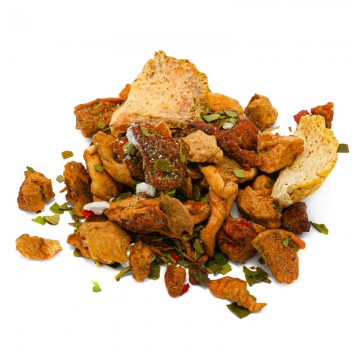



 No reward points for this product.
No reward points for this product.
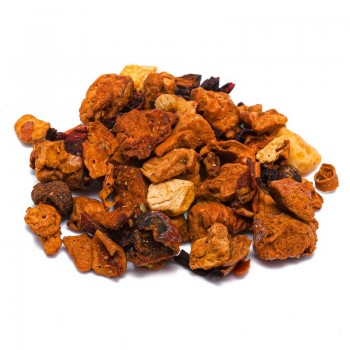

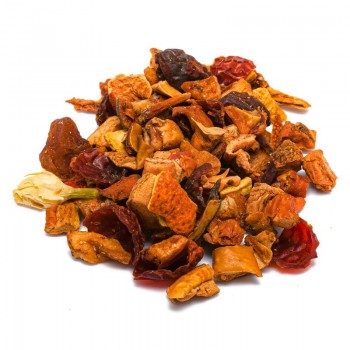

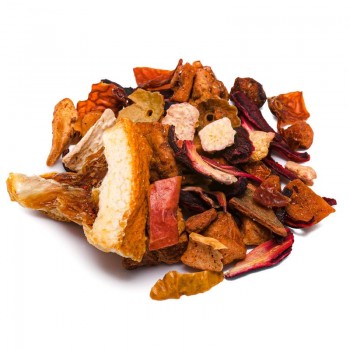

![infuso pesca melone [Natura d'Oriente]](https://www.naturadoriente.com/3535-home_default/infused-peach-melon.jpg)
